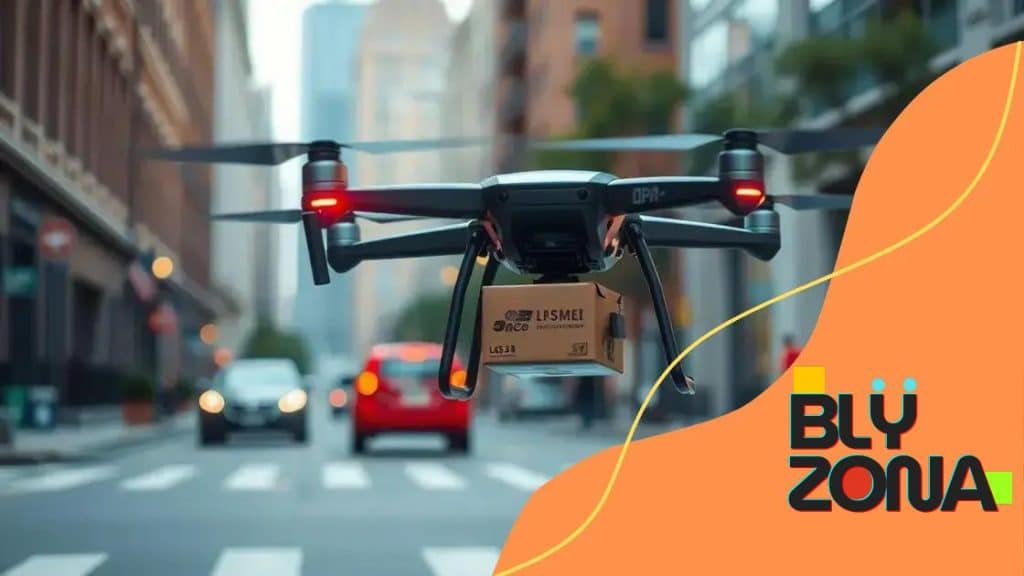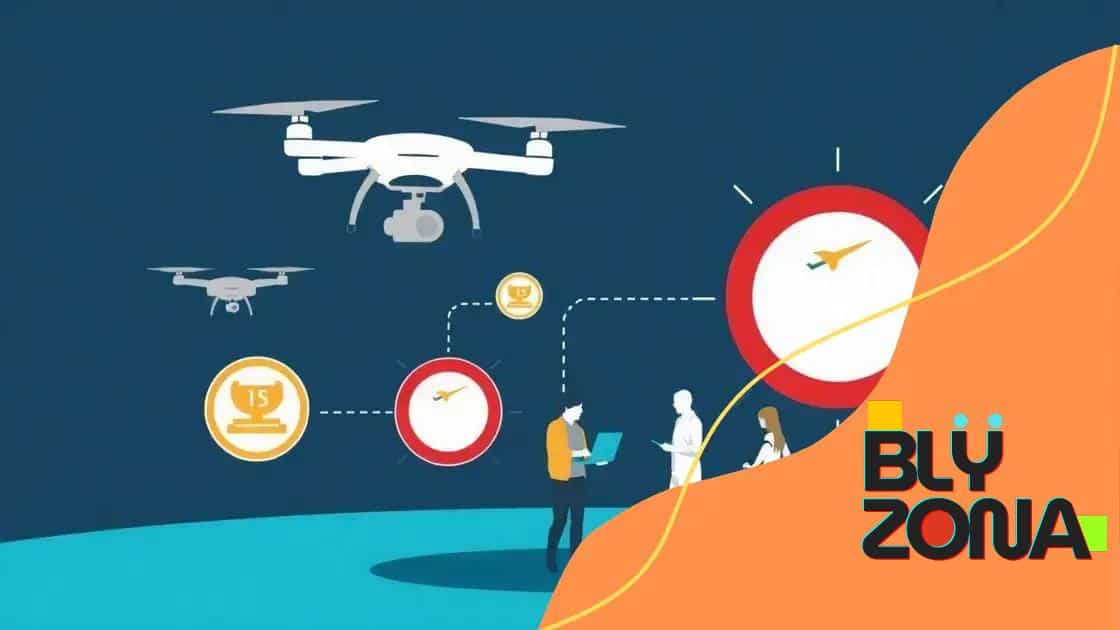Drone delivery regulations evolving worldwide: what you need to know

Drone delivery regulations are evolving globally, focusing on automation, safety, and sustainability, as technology advances and companies seek to meet regulatory requirements while addressing public concerns.
Drone delivery regulations evolving worldwide are reshaping how we think about logistics and convenience. Have you ever wondered how your packages might soon arrive on your doorstep? Let’s dive into this exciting topic together.
The current state of drone delivery regulations
The current state of drone delivery regulations is a rapidly evolving landscape. As technology advances, countries around the world are adapting their rules to manage the safe use of drones for delivering goods. Understanding these regulations is crucial for companies looking to innovate and expand their services.
Key Regulatory Frameworks
Different regions are implementing unique frameworks to govern drone deliveries. In the United States, the Federal Aviation Administration (FAA) plays a vital role in creating and enforcing these regulations. Similarly, other countries have their own regulatory bodies that outline specific laws and requirements.
- In the EU, the European Union Aviation Safety Agency (EASA) ensures safety across member states.
- Australia has its regulations governed by the Civil Aviation Safety Authority (CASA).
- China is developing a mix of strict and flexible rules to promote the use of drones.
- India has recently introduced Drone Regulations 2021 to facilitate commercial drone deliveries.
These varying regulations reflect cultural and economic differences in approaching drone technology. For example, while some countries emphasize stringent safety protocols, others prioritize fostering innovation and economic growth through more lenient rules.
Technology’s Impact on Regulations
As technology improves, it holds the potential to influence regulations significantly. More advanced drones can fly longer distances, carry heavier loads, and incorporate sophisticated navigation systems. This evolution leads to ongoing discussions around privacy, safety, and air traffic management.
Moreover, the introduction of automated delivery systems requires regulators to address new concerns. These may include identifying how to integrate drones with existing aviation traffic and ensuring that airspace is used safely. The feedback loop between innovation and regulation is crucial for developing frameworks that protect citizens while allowing for progress.
International cooperation is also becoming increasingly important. As drone technology knows no borders, countries must collaborate to create unified standards and practices. This can help mitigate issues such as airspace congestion and cross-border deliveries.
Ultimately, staying informed about the current state of drone delivery regulations is essential for stakeholders in the industry. By understanding the existing frameworks and technological advancements, companies can position themselves to thrive in this dynamic environment.
How countries are approaching drone delivery laws
As countries evaluate their approaches to drone delivery laws, various strategies emerge based on regional needs and technological advancements. Each nation takes its unique stance, impacting how drones operate commercially.
Diverse Regulatory Methods
Some countries prioritize strict safety measures while others focus on fostering innovation. For instance, in the United States, the Federal Aviation Administration (FAA) has established guidelines aimed at ensuring safety without stifling development. On the other hand, nations like New Zealand have opted for a more liberal approach, promoting drone usage in rural areas without extensive regulations.
- The U.S. emphasizes pilot training and airspace management to ensure public safety.
- New Zealand encourages businesses to utilize drones in delivery services through less bureaucratic red tape.
- China combines rigorous regulations with rapid technological adoption, creating a unique balance.
- In India, regulations are evolving quickly to promote a drone-friendly environment amidst safety concerns.
These different methods not only reflect individual government priorities but also highlight the influence of public acceptance and safety perceptions. Countries with high levels of public trust in technology are often more open to lenient regulations.
Influence of Technology on Drone Laws
The rapid progress in drone technology significantly shapes how nations formulate drone delivery laws. Autonomous flying systems and advanced navigation tools are encouraging some regions to streamline their regulatory frameworks. As flying vehicles become more reliable, countries are crawling toward adopting rules that embrace innovation while ensuring safety.
However, technological advancements also raise new questions and challenges. Issues such as privacy concerns and airspace congestion are prompting regulators to adapt existing laws continuously. Stakeholders must engage in ongoing dialogues to refine regulations based on real-world applications of this technology.
International collaboration is becoming increasingly vital. Countries are exchanging ideas and best practices to develop comprehensive frameworks that cater to the needs of a global market. This cooperation helps harmonize regulations, making it easier for companies to operate across borders and promoting the efficient use of drone technology.
The role of technology in shaping regulation

The role of technology in shaping regulation is becoming increasingly important as drone use expands globally. As innovations emerge, they challenge existing rules and push governments to adapt and rethink their regulatory frameworks.
Advancements Driving Change
Technology is evolving rapidly, introducing new capabilities in drones. These advancements make it necessary for regulators to stay updated. For instance, the development of autonomous flying systems has changed how drones can operate in various environments.
- Enhanced navigation systems allow for safer, more reliable flights.
- Obstacle detection technology makes flying in populated areas safer.
- Data collection features help regulators monitor drone activities closely.
- Electric drones with better batteries extend range and delivery options.
As these technologies become available, they create opportunities for regulatory agencies to create more efficient rules that incorporate these advancements. Governments are realizing that overly restrictive regulations can stifle innovation, so many are evolving toward a more balanced approach.
Collaboration Between Tech and Regulation
Another critical aspect is the collaboration between tech companies and regulatory bodies. Open dialogue enables developers to understand regulatory concerns while regulators gain insights into technological capabilities. This partnership is vital for crafting rules that protect the public without hindering progress.
Examples of successful collaborations include pilot programs, where companies work with local authorities to test new drone technologies under real-world conditions. These programs can offer invaluable feedback that helps adjust regulations to suit both parties’ needs.
Moreover, sharing best practices across countries can enhance regulatory frameworks worldwide. Countries can learn from each other’s experiences, speeding up the process of developing effective rules. Continued collaboration ensures regulations keep pace with technology while maintaining public safety.
Challenges faced by drone delivery services
Drone delivery services are gaining popularity, but they face numerous challenges that can affect their growth and efficiency. Understanding these issues is crucial for businesses looking to innovate in this industry.
Regulatory Hurdles
One of the main challenges is navigating complex regulations. Different countries and regions have varying laws that dictate how and where drones can be used. Companies need to comply with safety standards, privacy laws, and air traffic regulations. These requirements can change frequently and require constant monitoring.
- Licensing requirements for drone operators are often complicated.
- Restrictions on flying over populated areas can limit delivery options.
- Privacy concerns from the public can lead to additional scrutiny.
- Compliance with local laws can incur high costs for companies.
Such regulations can slow down the deployment of drone delivery services as companies must invest significant time and resources to ensure they are compliant.
Technical Limitations
Another major challenge relates to the technology itself. Although drone technology has advanced dramatically, it still faces limitations. Issues such as battery life, payload capacity, and navigational accuracy can affect delivery performance.
For instance, many drones have limited range and may not be able to deliver to farther locations efficiently. Furthermore, adverse weather conditions can hinder their operations. Companies must continually work on improving technology to overcome these hurdles.
Additionally, maintaining drones and performing regular safety checks can become costly and time-consuming, affecting the overall efficiency of the delivery service.
Public Perception and Acceptance
Public perception plays a vital role in the success of drone delivery services. Many people are still uncertain about the safety and reliability of drones. Concerns about noise pollution, safety risks, and privacy can lead to resistance from communities.
Building trust with the public involves communication and transparency. Companies must educate potential users about the benefits of drone delivery while addressing their concerns. Successfully managing public relations is critical for acceptance and growth.
As drone delivery services continue to evolve, they must navigate these challenges. Technology must keep pace with regulatory requirements while also addressing public concerns. This balancing act will determine the future success of drone delivery systems.
Future trends in drone regulation and logistics
The future trends in drone regulation and logistics are exciting and filled with potential. As technology advances, these trends will shape how drones are integrated into everyday logistics and delivery systems.
Increased Automation
One trend that is becoming apparent is the move toward greater automation in drone operations. As drones become more sophisticated, they will rely less on human operators. This shift could lead to enhanced efficiency in logistics, reducing costs and delivery times.
- Automated drones will operate using advanced AI for navigation and decision-making.
- Fewer manual controls will mean quicker response times for deliveries.
- Automation can improve safety by minimizing human error.
- Integration with smart infrastructure will open new delivery avenues.
This automation trend aligns with the overall push for efficiency in the logistics sector. Companies that adapt quickly may gain a competitive edge.
Regulatory Evolution
Another significant trend will be the evolution of regulations to keep pace with technological advancements. Governments are beginning to recognize the need for clear, cohesive regulations that promote innovation while ensuring public safety.
Future regulations may focus on:
Real-time tracking of drones to monitor their locations,
Dynamic air traffic management to integrate drones into existing air traffic systems,
New safety standards that continually evolve with technology, and
Streamlined processes for obtaining necessary permits.
These changes will help create a more supportive environment for drone operations and logistics.
Environmental Considerations
As sustainability becomes a priority, future drone regulations might also incorporate environmental considerations. Regulators may encourage the use of electric drones and restrict flights that contribute to noise pollution or environmental harm.
Drones powered by renewable energy sources will likely gain traction, contributing positively to logistics and reducing carbon footprints. Companies that embrace sustainable practices are not only likely to meet upcoming regulatory requirements but will also appeal to environmentally-conscious consumers.
Overall, the landscape of drone regulation and logistics is set to change significantly in the coming years. With advances in technology, evolving regulations, and growing environmental awareness, the future looks promising for the integration of drones into daily logistics.
FAQ – Frequently Asked Questions about Drone Delivery Regulations
What are the main challenges faced by drone delivery services?
Drone delivery services face challenges such as regulatory hurdles, technical limitations, and public acceptance. These issues can slow down implementation and affect efficiency.
How does technology influence drone regulations?
Technology advancements prompt regulators to evolve rules, ensuring safety while promoting innovation, such as automation and real-time tracking systems.
What trends are shaping the future of drone logistics?
Future trends include increased automation, regulatory evolution, and a focus on sustainability, as companies work to adopt environmentally-friendly practices.
Why is public perception important for drone delivery services?
Public perception affects acceptance; concerns about safety and privacy must be addressed to build trust and encourage the use of drone delivery solutions.





